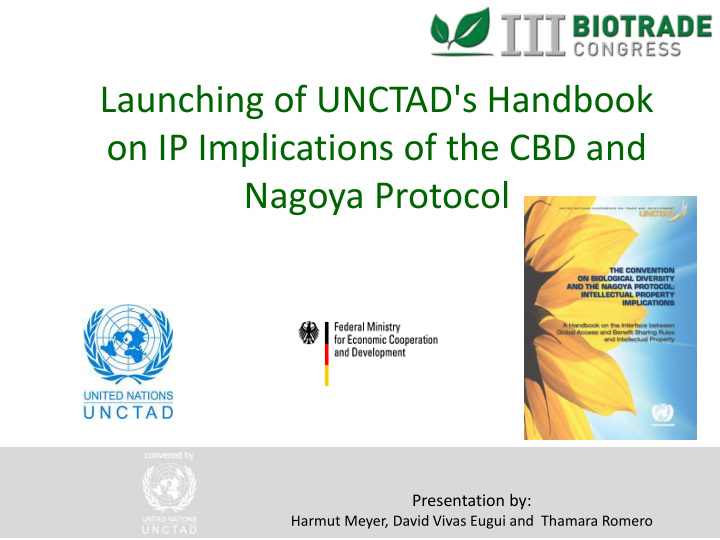



Launching of UNCTAD's Handbook on IP Implications of the CBD and Nagoya Protocol Presentation by: Harmut Meyer, David Vivas Eugui and Thamara Romero
Why a handbook on IP and Nagoya? Nagoya largely silent on IP but very important for ABS rule implementation … • Most successful R&D outcomes tend to be good candidates for IP Protection • Many inventions are the result of genetic resource utilization as defined by the protocol • Many inventions are inspired by or use TK • IP system can be supportive on biodiversity objectives is property devised and used • What does the handbook cover? • How can the handbook be used?
Protection of and Access to TK-GR • International framework for indigenous peoples and local communities since 2007 - right to control TK and IP over TK (DRIP Art. 31) - NP members shall take measures to ensure PIC and MAT when TK is accessed (NP Art. 7) • National implementation necessary - territorial nature of IPR and ABS - domestic establishment of rights and procedures - e.g. ABS compliance in the EU linked to ABS law in provider country
Regional and National Examples • Handbook analyses 7 examples of regulations on sui generis IP protection for TK and on ABS - defensive protection to a certain degree (fighting misappropriation) - barely any positive protection (supporting utilization) - no comprehensive approaches to link IPR and ABS • Development of common conceptual clarity, e.g. - Subject matter definition - Holder of rights - Scope of rights - TK in the public domain
The role of biodiversity related disclosure requirements (BRDRs) • Disclosure / description of the invention is a typical function of patent applications. • Disclosure of origin/source and Legal provenance has been often used to verify compliance of ABS in several legislations (about 50 countries). • IP offices can be a check point, even in the absence of binding disclosure provisions (e.g. draft ABS regulation in Germany) • There is no question of about TRIPS compliance. The handbook provides different modalities to introduce BRDRs in a way that is TRIPS compliant. • Other alternatives include exceptions to patentability and title holder's rights and competition policy, and unfair enrichment.
Distinctive signs and Biodiversity-based products • Geographical indications (GIs) and other distinctive signs, if properly designed, can make a significant contribution to conservation of biological resources and to sustainable use objectives under the CBD • GIs have proved to be useful in distinguishing products and producers with direct ties with the environment and traditional practices • There are increasing examples in developing countries • GIs are a voluntary scheme that can allow and valorize the introduction of sustainable practices and well as TK preservation measures • GIs can have a defensive value
UNCTAD Technical Cooperation on Nagoya Implementation • Handbook trial-run in UNCTAD blended learning courses in SE Asia (2012-13) and South Asia (2013-14); as well as in 2 day national workshop in Cambodia (2014). Distance learning modules that go with handbook are housed on donor (GIZ's) distance learning platform, GC21. • Handbook currently being used in GIZ blended learning workshop for Amazon-region countries • UNCTAD is currently accepting requests for technical assistance/capacity building
Thanks The handbook can be found at: http://unctad.org/en/PublicationsLibrary/diae pcb2014d3_en.pdf
Recommend
More recommend